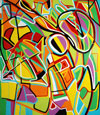Tempera
In tempera egg yolk is used is a painting medium. Some people enjoy the pleasure of preparing their own paint and to that purpose they grind their pigments and mix it with egg yolk. Care must be taken to remove all the egg's white, as white dries faster than yellow, causing craquelure. The yellow does cause some discoloration initially but bleaches quickly, producing a clear and transparent medium.
Oils
In the 15th century Flemish painter Jan van Eyck pioneered the use of oils as a painting medium. Building up thin layers of paint, known as glazing, is also possible using tempera, but oils produced a depth and luminosity that had never been seen before.
Although acrylics are gaining ground, oils are still the most popular painting medium today. The oilpaint comes as a paste, mostly in tubes, but can be diluted, either by turpentine or white spirit, or by a medium which is a mixture between oils and a thinner. A good medium dries to a glossy finish and doesn't crack when it dries, but care must be taken to obtain a good quality that doesn't contain impurities or else the medium with yellow quickly. Like the oilpaint itself, most media are slow to dry but have the advantage over turpentine especially and white spirit to some extent that slow drying media do not in general cause headaches and allergies. Today there are quickly drying media available, but then the above-mentioned health issues reappear.
Many painters use a medium to thin their paint because in it's undiluted form oilpaint isn't suitable to work a small details. Oil painters use undiluted oilpaint in thick layers in which the oil paint's texture plays a role in the painting's expressive effect. However, when precision is required one has to dilute the oil paint, or to make use of the oil paint's transparent qualities. For example, the transparency of the human skin is best painted by applying several layers of diluted transparent paint. The transparency of oil paint depends on the transparency of it's pigment. When applying thick layers, a technique which is called impasto, it's usually best not to use transparent paint. A transparent pigment absorbs most of the light without reflecting it and a thick layer of transparent paint will reflect very little and so produce a dark, usually unattractive effect. It depends on a painter's style, but in general one can say that for darker effects it's best to use a dark opaque paint, when applying thick layers. Vincent van Gogh is well known for the very expressive effects he was able to achieve with his impasto. The deep texture of brush strokes in thick layers of oil paint give his paintings their unique rhythm and expression.
Water mixable oil paint
Paintmaking is to a large degree a matter of chemical processes. In former days minerals were pulverized, mixed with oil and that was it. Nowadays chemical compounds are prepared under carefully controlled circumstances, in which for instance a slight change in acidity can change a pigment's color to change from yellow to red or from green to orange. The most interesting recent technique innovation in paint making is contained in water-mixable oil paint. Normally oil and water repel, water consisting of polar molecules, oil of non-polar carbon hydrates. Because repelling molecules don't mix, the oil's carbon hydrate polymers a cut into pieces by means of a chemical process that has been applied in the chemical industry for decades. This chemical process produces fractured molecules that are no longer non-polar a mix with water.
However, water-mixable oil paint isn't just water-mixable oil paint in the literary sense, it's a very different medium than conventional oil paint. If you use it undiluted there's not much difference with regular oil paint, but on dilution it acts like a hybrid of oil and acrylic paint. The solvents you use with oil paint, which are petro-chemical derivates, are much more aggressive solvents than water and therefore much "faster" solvents, speeding up the painting process. The paint brush absorbs and releases diluted oil paint more readily than water based paint, which makes regular oil easier to work with than water based paint.
|





